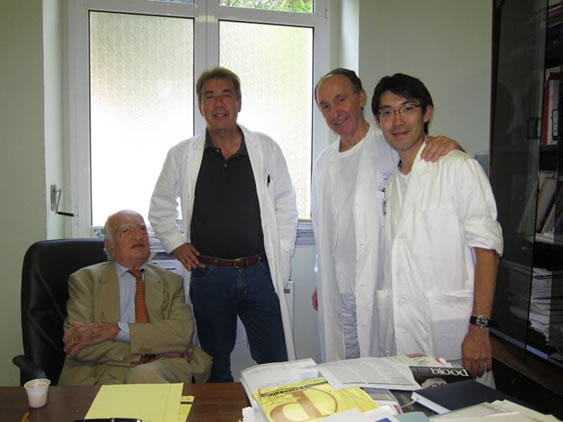(1) Intra-bone marrow cord blood transplantation
Cord blood is an important source for hematopoietic stem cell transplantation, alternative to the bone marrow or the stem cell-mobilized peripheral blood. Its advantages include ready availability, no burden to donors, and low allogeneic reaction.
Over 20,000 cord blood transplantations (CBT) have been performed to date, including over 7,000 in Japan. However, CBT is not applicable to the entire proportion of adult patients because a cord blood unit contains low number of nucleated cells. Comparing to transplants with other stem cell sources, however, higher risk of graft failure (approximately 20%), delayed recovery from cytopenia, and more serious immunodeficiency in the recipients are the major disadvantages of CBT, which preclude cord blood from being the first-line source. Consequent higher mortality and morbidity should be reduced by the advancement of methods and technology to improve safety and outcomes of CBT. In this regard, double cord transplants and ex-vivo expansion of cord blood stem cells have been under investigation.
Intra-bone marrow (iBM) CBT is another method among those challenges. An Italian group lead by Dr Frassoni reported safety and efficacy of 32 cases of CBT using this technique [1]. Dr Frassoni reported that iBM-CBT achieved high rate of engraftment (96%) and low incidence of acute GVHD (grade II-IV: 14%) [2]. The Eurocord-EBMT also demonstrated faster platelet recovery and decreased acute GVHD in iBM-CBT compared with double cord transplants [3]. Thus iBM-CBT appears to be an attractive option among other new methods to improve the outcome of CBT.
The purpose of my project was to investigate the clinical practice and the theoretical background regarding iBM-CBT. Two cases of iBM-CBT were performed during the project. The first case was 23-year-old woman with acute myelogenous leukemia in 2nd complete remission, and the second case was 26-year-old woman with therapy-related myeloid neoplasm in 1st complete remission. Especially in the first case, I could see all the procedure including the conditioning regimen, processing of the cord blood units, injection procedure of the cord blood units into the bone marrow, and the post-transplantation course until hematologic recovery. There was no complication related to the iBM-CBT procedure and the post-transplant course was favourable. The hematologic recovery was prompt, namely, time for neutrophil and platelet engraftment was 24 and 33 days, respectively. Since each procedure was not so complicated and special technique or reagent was not needed, I was sure that I could introduce this new technique to Japan immediately.
I could also learn theoretical background of iBM-CBT. Dr Frassoni showed in his previous report that the first-entry contact between injected cord blood and the hematopoietic microenvironment is significant in order to define their bone marrow homing. To confirm his theory, his group was performing a series of innovative experiments regarding cell trafficking and cell recovery after transplant. Participating in the series of experiments and having discussion with Dr Frassoni and his colleagues yielded insights about iBM-CBT.
Undoubtedly, cord blood will be the more and more important source for transplant in the future, given the increasing demand for the allogeneic transplants and a definite limitation in the expansion of related as well as unrelated donors. I believe that cord blood can be the first-line source for allogeneic transplant, once the overall outcomes reach those with bone marrow and stem cell-mobilized peripheral blood. It is interesting that over 7,000, unproportionally large number of CBT has been performed in Japan. Given the fact that this is roughly one third done in the world, it is our responsibility to improve the outcomes of CBT. Through this project, I was assured iBM-CBT was the very way to fulfil our responsibility. It was extremely useful to learn directly by joining Dr Frassoni’s group, a front-runner in this research field, for a short period of time. I started preparing for clinical trial of iBM-CBT in Japan just after returning back to Japan. I hope it will contribute to major progress in hematology and transplant medicine.
- [1] Frassoni F, et al. Direct intrabone transplant of unrelated cord-blood cells in acute leukaemia: a phase I/II study. Lancet Oncol 2008; 9: 831-9.
- [2] Frassoni F, et al. The intra-bone marrow injection of cord blood cells extends the possibility of transplantation to the majority of patients with malignant hematopoietic diseases. Best Pract Res Clin Haematol 2010; 23: 237-44.
- [3] Rocha F, et al. Unrelated cord blood transplantation: Comparison after single unit cord blood intrabone injection and double unit cord blood transpanttion in patients with hematological malignant disorders. A Eurocord-EBMT analysis. Blood abstr 2010.
- [4] Massollo M, et al. Contact with the bone marrow microenvironment readdresses the fate of transplanted hematopoietic stem cells 2011; 38: 968-77.
(3) Unmanipulated Haploidentical Stem Cell Transplantation
A limitation of allogeneic transplantation is availability of a donor because only a small percentage of patients have an HLA-identical sibling in advanced countries. Although it is obvious that CBT is one of the solutions, haploidentical transplantation is another promising option. There are some advantages of using HLA?haploidentical family donors. First, haploidentical transplantation offers an immediate source of hematopoietic stem cells for almost all patients. Second, stem cell procurement and further collection of donor cells for cellular therapy are easier compared to using unrelated donor. But the major disadvantages of HLA-haploidentical transplantation were high rates of graft rejection and severe GVHD. Several strategies such as ex-vivo T-cell depletion and intensive immunosuppression had been proposed but these problems have yet to be resolved.
Dr Bacigalupo of San Martino Hospital is vigorously investigating haploidentical transplantation using unmanipulated haploidentical graft. The ingenious point of his study is use of post-transplant high-dose cyclophosphamide as GVHD prophylaxis in a setting of myeloablative conditioning regimen. He reported safety and efficacy of 18 cases of haploidentical transplantation at 16th congress of EHA. In the presentation, he emphasized its high engraftment rate, reliable and complete hematologic recovery, acceptable transplant mortality, and promptness of haploidentical transplantation.
I saw about 10 cases of haploidentical transplantation using post-transplant high-dose cyclophosphamide in San Martino Hospital. All patients were engrafted and GVHD was mild. It was notable that immune recovery after the haploidentical transplantation was prompt and viral infections were not a problem in the series of cases. I felt strongly that the procedure could be performed in Japan after minor modification of their protocol. I started organizing the new clinical trial of haploidentical transplantation using post-transplant high-dose cyclophosphamide in our facility.
(4) Conclusive word
Throughout the project, I met a lot of frontline researchers and had discussion with them. It was extremely fruitful experience for me.
Although some Japanese groups have achieved solid results in the field of hematopoietic stem-cell transplantation, a lot of things remain to be learnt from European countries. I recognized some factors of the competitiveness of European countries in transplantation medicine. First, transplantation cases are accumulated to a few large transplantation centers in Europe, while Japanese transplantation patients are distributed to many small transplantation facilities. This enables large-scale clinical trials both prospectively and retrospectively. Second, appropriate data management system can realize effective usage of the accumulated information. Third, and this is most important, there has been a blossoming of interaction between clinical researchers not only nationwide but also worldwide. For example, huge numbers of multicenter clinical trials are being performed wherever I visited. International meetings are frequently held and European researchers can have opportunities to participate and exchange their ideas.
I was very pleased to join the organic interaction between these researchers. I will sustain and develop this valuable relationship and make the most of it throughout my carrier.
(5) Acknowledgement
I appreciate valuable suggestions and generous support of Dr Frassoni, Dr Bacigalupo, and their colleagues. I am grateful to Prof Foa and Dr Torelli of University of Rome, Dr Gluckman and Dr Ruggeri of Eurocord, Dr Xhaard and her colleagues of Saint-Louis Hospital, Prof Staal, Dr Zwaginga, and Dr Brugman of Leiden University for their kind hospitality during my visit. I thank EHA and JSH for selecting me as a winner of the award and giving me the opportunity to have precious experiences.


